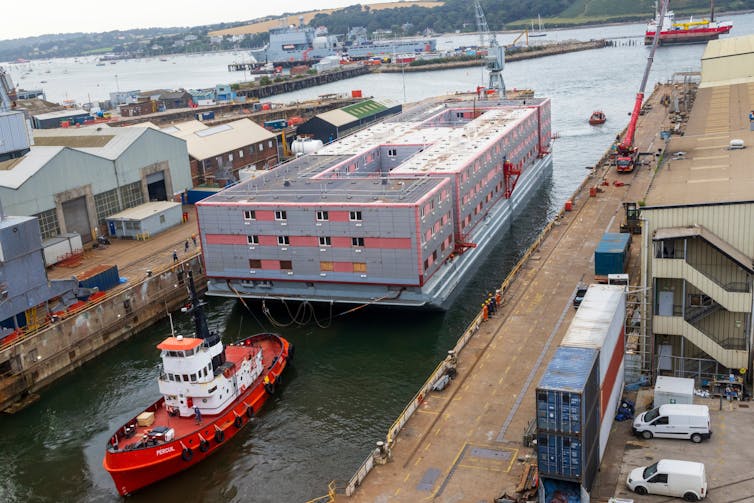The number of refugees worldwide has been increasing since 2012. At the end of 2022, there were 35.3 million refugees globally.
While some politicians have suggested that the UK is being overwhelmed by refugees, 76% of the world’s refugees are hosted in low- and middle-income countries. In Europe, Germany, France and Spain receive more asylum applications each year than the UK.
As long as there is war and persecution, there will be people in need of protection. So how should countries handle the flow of people?
This is the question driving much political debate. The UK government appears committed to its policy of sending refugees to Rwanda. Charities are calling on political leaders to commit to a fair new plan for refugees. Meanwhile, the death of a man on a barge housing asylum seekers has reinvigorated concerns about the welfare of people who seek refuge in the UK.
Here are four questions (and answers) to help you make sense of it all.
Who counts as a refugee?
Under the refugee convention of 1951 – which the UK and most other countries are party to – a refugee is a person who fears being persecuted, to the point that it is unsafe to return to their home country. Persecution means a person faces a threat to their life or freedom, or fears another serious violation of their human rights, such as torture or sexual violence.
A refugee must be persecuted because of their race, religion, nationality, political opinion or membership of a social group. Examples of social groups include women, LGBTQ+ people and children.
A person who has left their home country to seek protection, but has not yet been formally recognised as a refugee, is often referred to as an “asylum seeker”.
What obligations do governments owe refugees?
As a party to the refugee convention, the UK is legally obliged to abide by its provisions, including the principle of “non-refoulement” – that is, not sending a refugee to a country where their life or freedom is threatened. This can be the refugee’s home country or any other country where there is a risk to their life or freedom.
This was why the UK supreme court found that the Rwanda plan was unlawful – because there was a risk that Rwanda would not decide asylum claims properly and thus return genuine refugees to their countries of origin.
Governments should also ensure an adequate standard of living for new arrivals, including by providing access to shelter, healthcare and education for refugee children. The UN has emphasised the importance of a people-centred, sensitive and humane approach to people seeking asylum.
The Bibby Stockholm, the barge where an asylum seeker reportedly took his own life, has been criticised by charities, experts and politicians. Many argue that the close quarters, health concerns and isolation of being housed at sea are not an adequate standard of living.

How many people who travel to the UK are genuine refugees?
So far, in 2023, over 29,000 people have travelled to the UK on small boats to seek asylum.
Government statistics indicate that 75% of people who claim asylum in the UK are granted refugee status or another type of permission to remain in the UK. For some nationalities, the figure is higher – 100% of applicants from Eritrea, 99% of those from Afghanistan and 99% from Syria are recognised as refugees.
However, many of the people who have travelled to the UK in recent years are part of the 165,000 people in the UK’s “asylum backlog”. This means they are still waiting for the government to decide their asylum claim. While the government is working to reduce the backlog, current schemes risk prioritising quick decisions over accurate decisions.
Why don’t refugees travel to the UK legally?
There are many reasons refugees may not travel to the UK through regular, legal routes. One of the main reasons is that to come to the UK legally, a person must be granted a visa – for example, because they intend to work or study in the UK.
The government has created special visas for people fleeing Ukraine, Afghanistan and Hong Kong. In the past year, the government has allowed 112,000 people to come to the UK through these routes, including 64,000 people from Ukraine.
However, refugees from other countries do not have access to the same opportunities to apply for a visa in order to seek asylum. The absence of safe and legal routes forces them to travel irregularly.
Contrary to popular belief, refugees are not required to seek asylum in the “first safe country” they enter. A government report found that refugees seek asylum in the UK for many reasons, including that they have relatives in the UK, speak English and because of the UK’s reputation as a safe and tolerant democracy.

